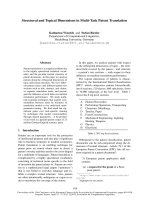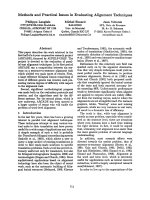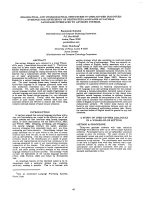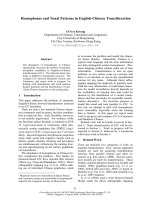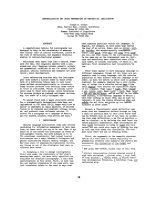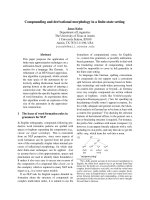Báo cáo khoa học: "Ethnic and geographical differences in HLA associations with the outcome of hepatitis C virus infection" pot
Bạn đang xem bản rút gọn của tài liệu. Xem và tải ngay bản đầy đủ của tài liệu tại đây (263.2 KB, 8 trang )
BioMed Central
Page 1 of 8
(page number not for citation purposes)
Virology Journal
Open Access
Research
Ethnic and geographical differences in HLA associations with the
outcome of hepatitis C virus infection
Jane H Wang*
1,2,8
, Xin Zheng
3
, Xiaogang Ke
1
, M Tevfik Dorak
4
,
Jingjing Shen
1
, Basmattee Boodram
5
, Maurice O'Gorman
6
,
Kenneth Beaman
3
, Scott J Cotler
1
, Ronald Hershow
5
and Lijun Rong*
7
Address:
1
Division of Hepatology, Department of Medicine, University of Illinois at Chicago, IL, USA,
2
Division of Gastroenterology, Hepatology
and Nutrition, Department of Pediatrics, the Feinberg School of Medicine, Northwestern University, Chicago, IL, USA,
3
Clinical Immunology
Laboratory, Rosalind Franklin University of Medicine and Science, Chicago, IL, USA,
4
Genomic Immunoepidemiology Laboratory, HUMIGEN
LLC, The Institute for Genetic Immunology, Hamilton, NJ, USA,
5
Division of Epidemiology and Biostatistics, School of Public Health, University
of Illinois at Chicago, Chicago, IL, USA,
6
Division of Clinic Immunology, Department of Pediatrics, the Feinberg School of Medicine,
Northwestern University, Chicago, IL, USA,
7
Department of Microbiology and Immunology, University of Illinois at Chicago, Chicago, IL 60612,
USA and
8
B&H Biotechnologies, Willowbrook, IL 60527
Email: Jane H Wang* - ; Xin Zheng - ; Xiaogang Ke - ; M
Tevfik Dorak - ; Jingjing Shen - ; Basmattee Boodram - ;
Maurice O'Gorman - ; Kenneth Beaman - ; Scott J Cotler - ;
Ronald Hershow - ; Lijun Rong* -
* Corresponding authors
Abstract
Backgrounds: The association of human leukocyte antigen (HLA) genes with the outcome of
hepatitis C virus (HCV) infection may be modified by ethnic and geographical differences.
Results: HLA-A, -C, -DRB1 and -DQB1 genotyping were performed in a Midwestern American
cohort of 105 HCV infected subjects among which 49 cleared HCV infection and 56 had persistent
viral infection. A new protective association of HLA-Cw*05 to HCV infection of all ethnic
populations was identified (OR = 0.12, 95% CI = 0.01–0.97, P = 0.03). It was surprising that HLA-
A*02 (P for interaction = 0.02) and HLA-DRB1*12 (P for interaction = 0.05) showed statistical
interaction with race indicating opposite associations in Caucasians (OR = 2.74 for A*02 and 2.15
for DRB1*12) and non-Caucasians (OR = 0.41 for A*02 and 0.15 for DRB1*12). In addition, HLA-
DRB1*01 (OR = 0.26), DQB1*05 (OR = 0.23) and the haplotype DRB1*01-DQB1*05 (OR = 0.19)
showed strong associations with viral clearance in Caucasians. The protective associations of A*03
(OR = 0.20) and DQB1*03 (OR = 0.20) were exclusive to non-Caucasians. In contrast, DQB1*02
(OR = 2.56, 95% CI = 1.15–7.71, P = 0.02) and the haplotype DRB1*07-DQB1*02 (OR = 5.25, 95%
CI = 1.04–26.6, P = 0.03) were risk markers in Caucasians.
Conclusion: The associations of HLA-A*02 and HLA-DRB1*12 with HCV infection are opposite
with different races. HLA-A*03, Cw*05, DRB1*01, DQB1*03 and DQB1*05 are associated with
viral clearance while HLA-DRB1*07 and DQB1*02 are risk markers for viral persistence of HCV
infection in Midwestern Americans. These results reveal ethnically and geographically different
distribution of HLA-genes which are associated with the outcome of HCV infection.
Published: 1 May 2009
Virology Journal 2009, 6:46 doi:10.1186/1743-422X-6-46
Received: 13 April 2009
Accepted: 1 May 2009
This article is available from: />© 2009 Wang et al; licensee BioMed Central Ltd.
This is an Open Access article distributed under the terms of the Creative Commons Attribution License ( />),
which permits unrestricted use, distribution, and reproduction in any medium, provided the original work is properly cited.
Virology Journal 2009, 6:46 />Page 2 of 8
(page number not for citation purposes)
Backgrounds
Hepatitis C virus (HCV) has infected at least four million
Americans and more than 200 million individuals glo-
bally. Over 70% of the patients develop chronic infection
leading to end stage liver diseases and, in many cases,
death [1,2]. Cellular immunity is believed to play a central
role in the host control of HCV infection [3-12]. To elicit
an adaptive cellular immune response, HCV antigens are
processed into peptides that bind human leukocyte anti-
gen (HLA) molecules. These are then presented on the cell
surface of either antigen presenting cells or on infected
cells such as hepatocytes. CD8 or CD4 T cells can recog-
nize the complex of HLA- class I peptides or class II pep-
tides and act as either effector T cells, helper T cells, or
regulatory T cells through direct killing, cell-contact or by
secreting cytokines, respectively [3,5-9,13].
It has been reported that HLA-alleles are associated with
the outcome of HCV infection. The majority of such stud-
ies have been focused on the associations between HLA-
class II alleles and HCV infection. In addition, the
reported associations showed ethnic and geographical dif-
ferences [14-20]. One study of a Northeastern American
population in Baltimore showed that HLA-DQB1*03 is
protective in African Americans but not in Caucasians
[18]. The results of another study of Northeastern Ameri-
cans in Philadelphia conversely suggested that DQB1*03
is protective in Caucasians but not in African Americans
[14]. Therefore, further study on ethnic and geographical
differences in HLA associations with the outcome of HCV
infection is needed.
We have identified HCV-infected subjects through a
cohort that enrolled young injection drug users with a
defined date of HCV acquisition in Chicago area, Illinois.
In the present study, we show that HLA association with
the outcome of early HCV infection is significantly differ-
ent among different races.
Results
Subjects with HCV infection
One hundred and five subjects who were exposed to HCV
in the Chicago area were divided into two groups: group
1 included 56 patients with persistent HCV infection and
group 2 included 49 subjects with spontaneous viral clear-
ance (Table 1). Chronic HCV infection was determined by
persistently positive detection of HCV-RNA and antibod-
ies in the blood samples collected at each patient visit dur-
ing the cohort. Spontaneous viral clearance was
determined by detectable HCV antibodies, undetectable
HCV-RNA and consistently normal values of serum
alanine aminotransferase. In statistical comparisons, the
persistent HCV-infected group was treated as cases and the
clearance group as controls.
Caucasians comprised 46.9% of the clearance group and
58.9% of the persistent group, respectively. A trend of sus-
ceptibility for Caucasians was observed (OR = 1.62, 95%
CI = 0.75–3.52, P = 0.22). Among the non-Caucasian
population, 60~65% was Hispanic Latino American,
23~30% was African American, 7~9% was mixed races
and 3% was others (Table 1). There were no differences in
age, gender or estimated years of infection between the
two groups which could have contributed to the observed
differences (Table 1).
Associations of HLA-class I alleles with HCV infection
The frequencies of HLA-A and -C alleles are shown in
Table 2. A trend of risk association of HLA-A*01 (OR =
2.41) was observed among the Caucasian population, but
this was not statistically significant. HLA-A*02 showed
opposing trends in different ethnic groups: risk for Cauca-
sians (OR = 2.74) and protective for non-Caucasians (OR
= 0.41). Although these associations were not statistically
significant, an interaction with race (the difference
between the ORs for each race) was evident (P for interac-
tion = 0.02). Protective associations of HLA-A*03 to HCV
infection with high dose viral inoculation has been
reported in European Caucasians [18]. Our data indicate
that A*03 is significantly protective for non-Caucasians
(OR = 0.20) but not for Caucasians (Table 2). HLA-A*11
in Northeastern American Caucasians in Baltimore has
been reported to be protective for HCV clearance [18]. In
our study, A*11 (OR = 0.55) demonstrated a weak trend
of protective association (Table 2).
A weak protective association of Cw*05 has been
observed in European Caucasians[15]. Surprisingly, HLA-
Cw*05 frequency in chronic infection and viral clearance
is 0.89% versus 7.14%, respectively, suggesting a strong
Table 1: Characteristics of study subjects
HCV Race (%) Gender (%) Age Inf time (yrs) Total
Infection Cauc non-Cauc Male Female Mean (range) Mean (range) (n)
Persistence 33 (58.9) 23 (41.1) 33 (58.9) 23 (41.1) 25.6 (19~32) 2.5 (0.1~6.0) 56
Clearance 23 (46.9) 26 (53.1) 29 (59.2) 20 (40.8) 26.0 (19~33) 2.6 (0.1~6.6) 49
Note: Cauc: Caucasian; Inf: infection; yrs: years; n: number.
Virology Journal 2009, 6:46 />Page 3 of 8
(page number not for citation purposes)
protective association of Cw*05 and HCV resolution (OR
= 0.13). A strong protective association of Cw*01 to HCV
clearance has been reported in European and Northeast-
ern American Caucasians in Baltimore [15,17]. Our data
show that the allele frequencies of Cw*01 in chronic
infection and viral clearance is 1.79% versus 4.08%,
respectively, but this difference is not statistically signifi-
cant (Table 2).
The risk association of Cw*04 with viral persistence has
been reported in both Caucasians and non-Caucasians of
Northeastern Americans in Baltimore [15,17]. Neither
protective nor risk associations of the two alleles with
HCV infection were observed in either Caucasians or non-
Caucasians in the present study.
The associations of HLA-class II alleles with HCV infection
The protective associations of DRB1*0101 and
DQB1*0501 have been documented in Northeastern
American Caucasians in Baltimore whereas in African
Americans, viral clearance is mainly associated with
DQB1*0301 [18]. Our data confirmed that both
DRB1*01 and DQB1*05 had a strong association with
viral clearance in Caucasians (Table 3). Consistently,
HLA-DQB1*03 protective association was exclusive to
non-Caucasians (Table 3). Among the non-Caucasian
subjects involved in our study, 60~65% were Hispanic
Latino Americans and 23~30% were African Americans.
The frequencies of DQB1*03 in Hispanic Latino Ameri-
cans and African Americans are 50% and 33.3%, respec-
tively. Thus our data, as well as others' findings, indicate
that the DQB1*03 protective association is equally strong
in African Americans [18] and Hispanic Latino Americans.
We found strong linkage disequilibrium (LD) between
HLA-DRB1*01 and DQB1*05 (Δ = 0.0419, P = 0.0009) as
expected. Because of strong LD, co-occurrence of these
two alleles in the same individual was considered as a
haplotype. Logistic regression analysis demonstrated that
there is a strong protective association with the haplotype
DRB1*01-DQB1*05 (OR = 0.20). This is statistically sig-
nificant in Caucasians only (OR = 0.19). The DRB1*01-
DQB1*05 haplotype association remains statistically sig-
nificant in combination with all other markers as shown
by multivariable logistic regression analysis (OR = 0.11,
95% CI = 0.27 to 0.46, P = 0.002). Thus, it appears to be
Table 2: HLA-class I allele frequencies of HCV infected subjects
Allele Chronic(%) 2n = 112 Clearance (%) 2n = 98 Odds Ratio 95% CI p-value
A*01 15.2 9.18 2.05 0.79–5.32 0.14
A*02 26.8 26.0 1.04 0.48–2.24 0.92
Caucasian 30.3 17.4 2.07 0.82–5.21 0.12
non-Cauc 21.7 32.7 0.57 0.23–1.42 0.23
A*03* 9.82 16.7 0.54 0.24–1.20 0.14
A*11 3.57 6.25 0.55 0.15–2.08 0.38
A*23 1.79 4.17 0.42 0.07–2.38 0.33
A*24 10.7 15.0 0.94 0.37–2.38 0.90
A*25 1.79 1.25 1.78 0.16–20.2 0.64
A*29 5.34 1.25 0.18 0.02–1.50 0.12
A*30 7.14 3.12 2.56 0.64–10.2 0.19
A*31 3.57 5.21 0.68 0.17–2.68 0.58
A*32 1.79 4.17 0.42 0.07–2.38 0.33
A*33 2.68 1.04 2.71 0.27–27.0 0.39
A*68 2.68 4.17 0.64 0.14–2.08 2.99
A*74 2.68 1.04 0.37 0.04–3.66 0.62
Cw*01 1.79 4.08 0.57 0.09–3.55 0.55
Cw*02 9.84 7.16 1.47 0.52–4.13 0.47
Cw*03 10.7 9.18 1.21 0.46–3.18 0.70
Cw*04 16.9 13.2 1.31 0.56–3.06 0.53
Cw*05 0.89 7.16 0.12 0.01–0.97 0.03
Cw*06 8.94 9.18 1.11 0.40–3.09 0.84
Cw*07 28.6 28.6 0.88 0.41–1.91 0.75
Cw*08 4.46 3.06 1.18 0.25–5.55 0.84
Cw*12 3.58 6.12 0.55 0.15–2.08 0.38
Cw*15 3.58 2.05 1.81 0.32–10.3 0.51
Cw*16 7.15 8.16 0.85 0.29–2.48 0.77
*: A*03 is protective for non-Caucasians, OR = 0.20, 95% CI = 0.04–1.01, P = 0.04
Note: Only those alleles except Cw*05 with more than 1.0% frequency in both comparison groups are shown.
Non-Cauc: non-Caucasians.
Virology Journal 2009, 6:46 />Page 4 of 8
(page number not for citation purposes)
the primary association. This result is consistent with
another study performed on Northeastern Americans in
Baltimore [18].
The DQB1*02 yielded high OR (1.8) for risk association
in combined ethnic populations. Consistent with others
reports [15,18], the association was stronger in Cauca-
sians (OR = 3.0, Table 3) and not significant in non-Cau-
casians. The haplotypic association of DRB1*03-
DQB1*02 has been reported in both European and Amer-
ican Caucasians [15,18] but it was not observed in our
study. Interestingly, the co-occurrence of DRB1*07-
DQB1*02 (OR = 5.25) was very significant in Caucasians.
Strong linkage disequilibrium between DRB1*07 and
DQB1*02 (Δ = 0.0351, P = 0.005) suggests that
DRB1*07-DQB1*02 occurred as a haplotype.
HLA-DRB1*07-positive individuals appeared to be sus-
ceptible to chronic HCV infection (OR = 2.42). When
stratified by race, the risk association with DRB1*07 was
stronger in Caucasians (OR = 3.81, Table 3). This associa-
tion has also been reported in European Caucasians [15].
However, the results of multivariable logistic regression
analysis indicated that DRB1*07 association did not
remain significant in the presence of other associated
markers (Cw*05, DRB1*01-DQB1*05, DQB1*03). This
suggests that DRB1*07 association was mediated through
the reciprocal effect of the others and it is not a primary
association.
DRB1*13 showed a trend of risk association in combined
ethnic population (OR = 1.62), which was stronger in
non-Caucasians (OR = 2.61) (Table 3). DQB1*04 yielded
a very high OR (4.23) in non-Caucasians which was not
statistically significant (Table 3).
DRB1*12 was another allele whose positivity showed
opposing associations in Caucasians (OR = 0.15) and
non-Caucasians (OR = 2.53, both were non-significant).
As with HLA-A*02, however, the interaction test yielded
statistical significance for the difference of the odds ratios
(P = 0.05). Thus, this is another example of effect modifi-
cation of an HLA association by race.
Multivariable model
A multivariable model consisting of all markers that
yielded OR < 0.5 or OR > 2.0 was constructed. In this
model, only the co-occurrence of DRB1*01-DQB1*05,
DQB1*03 and race remained independent associations.
The adjusted ORs were 0.11 for DRB1*01-DQB1*05; 0.25
for DQB1*03 and 2.40 for Caucasians.
Protective and risk associations of HLA- alleles with HCV
infection
Taken together, our results suggest the HLA-gene control-
led associations to HCV infection differed among differ-
ent ethnic populations and geographical locations. In
Table 4, we present the protective and susceptibility asso-
ciations of HLA-alleles with HCV infection of Europeans
Table 3: HLA-class II allele frequencies of HCV infected subjects
Allele Chronic (%)
(2n = 112)
Clearance (%)
(2n = 98)
Odds Ratio 95% CI p-value
DRB1*01 6.25 14.6 0.37 0.12 – 1.08 0.07
Caucasian 7.58 19.6 0.27 0.13 – 1.00 0.05
DRB1*03 14.3 10.4 1.56 0.63 – 3.86 0.34
DRB1*04 13.4 18.7 0.83 0.35 – 1.98 0.68
DRB1*07 17.0 8.35 2.42 0.95 – 6.23 0.07
DRB1*09 1.60 2.08 0.87 0.12 – 6.24 0.89
DRB1*11 10.7 12.5 0.84 0.34 – 2.09 0.71
DRB1*12 4.46 6.25 0.70 0.20 – 2.46 0.58
DRB1*13 16.1 9.38 1.62 0.64 – 4.12 0.31
DRB1*14 3.70 8.35 0.46 0.12 – 1.68 0.24
DRB1*15 9.82 6.25 1.75 0.60 – 5.15 0.31
DRB1*16 2.67 2.08 1.33 0.21 – 8.31 0.76
DQB1*02 25.9 16.3 1.79 0.91 – 3.54 0.09
Caucasian 34.8 15.2 2.98 1.15 – 7.71 0.02
DQB1*03 28.6 40.8 0.39 0.18 – 0.92 0.02
non-Cauc 23.9 44.2 0.20 0.06 – 0.67 0.01
DQB1*04 5.40 2.10 4.24 0.76 – 23.6 0.10
DQB1*05 10.7 21.4 0.42 0.18 – 1.01 0.05
Caucasian 9.10 23.9 0.23 0.07 – 0.82 0.02
DRB1*06 29.4 19.4 1.72 0.79 – 3.76 0.17
Note: only alleles with more than 1.0% frequency in both comparison groups are shown. non-Cauc: non-Caucasian.
Virology Journal 2009, 6:46 />Page 5 of 8
(page number not for citation purposes)
and Americans found by others and in the present study.
HLA-A*11, B*57 are protective and Cw*04 confers risk to
HCV infection in both American Caucasians and African
Americans. HLA-A*03 is protective for European but not
American Caucasians. In addition, the protective associa-
tion of A*03 to viral clearance is significant in non-Cauca-
sians (Tables 2 and 4). Furthermore, the strong
association of Cw*05 in combined ethnic populations
suggests that this allele protects both American Cauca-
sians and non-Caucasians.
Many of the associations, however, are related to race.
Protective associations of Cw*01, DRB1*01, DRB1*11
and DQB1*05 and risk associations of A*01, A*02,
DQB1*02 and DRB1*07 are significant only in Cauca-
sians (Table 4). The association of HLA-DQB1*03 to HCV
clearance are affected by geographical location. Two
reports, including ours, indicate that the association is sig-
nificant only in non-Caucasian Americans while two
other studies show that it is significant in American and
European Caucasians but not in African Americans (Table
4). Overall, it appears that risk associations of especially
class II alleles are less common in non-Caucasians (Table
4).
Discussion
The current study investigated the associations of HLA-
class I and -class II alleles to the outcome of early HCV
infection in a Midwestern American population. Similar
to other two studies of Northwestern Americans in Balti-
more and Philadelphia, subjects of this study were partic-
ipants of a cohort that enrolled injection drug users in the
Chicago area with defined dates of HCV acquisition, viral
loads, serum levels of alanine aminotransferase and eth-
nicity. Our data confirmed some of the results from the
study on Northeastern Americans in Baltimore [17,18].
A new protective association of HLA-Cw*05 and a risk
association of haplotype DRB1*07-DQB1*02 to HCV
infection were identified in the present study. In addition,
the DQB1*03 was found to be significantly protective in
non-Caucasians. It is interesting that our study revealed
the modification of an HLA association by race. HLA-
A*02 showed opposing trends in different ethnic groups:
risk for Caucasians (OR = 2.74) and protective for non-
Caucasians (OR = 0.41) DRB1*12 was another allele
whose positivity showed opposing associations in Cauca-
sians (OR = 0.15) and non-Caucasians (OR = 2.53) and
the interaction test yielded statistical significance for the
difference of the odds ratios for both A*02 and DRB1*12
(P < 0.05).
Table 4: Protective and susceptibility HLA-alleles in different races
Caucasians non-Caucasian Americans*
Allele European American AA HL Reference
Protective
A*02 Chicago Chicago Present
A*03 Irish** Chicago Chicago 15, Present
A*11 Baltimore Baltimore 17
B*27 Irish 15
B*57 Baltimore Baltimore 17
Cw*01 Irish Baltimore 15, 17
Cw*05 Chicago Chicago Chicago Present
DRB1*01 Irish Baltimore, Chicago 15, 17, present
DRB1*11 British, Italian Philadelphia 14, 16, 19
DRB1*12 Chicago Chicago Present
DQB1*03 British Philadelphia Baltimore 14, 18, 19
Chicago Chicago Present
DQB1*05 Irish Baltimore, Chicago 15, 18, 19
Susceptibility
A*02 Chicago Present
A*23 Baltimore 17
Cw*04 Baltimore Baltimore 17
DRB1*03 Irish, German Baltimore 15, 18, 20
DRB1*07 British Chicago 19, present
DRB1*12 Chicago Present
DQB1*02 Irish Baltimore, Chicago 15, 17, present
*: All Americans are injection drug users; AA: African American; HL: Hispanic Latino American. **: Irish females. Sample size (n): Irish: 227; British:
250; Baltimore:548/675; Chicago: 105; Philadelphia: 93; German: 75; and Italian: 73.
Virology Journal 2009, 6:46 />Page 6 of 8
(page number not for citation purposes)
Our results and other studies demonstrate associations of
genes encoding HLA-class I antigens with the outcome of
HCV infection (Table 4). Some associations are race and
geography dependent. For example, a strong protective
association of Cw*01 to HCV clearance has been reported
in European and Northeastern American Caucasians but
not in African Americans in Baltimore [15,17]. In addi-
tion, the association of A*03 to viral clearance has been
observed in European Caucasians but not American Cau-
casians (see Table 4). However, it appears that class I HLA-
allele associations are less dependent on ethnicity. For
example, four out of six associations in Americans, includ-
ing the protective association of HLA-A*03, A*11, B57,
Cw*01, Cw*05 and the risk association of Cw*04 to HCV
infection were statistically significant in both Caucasians
and non-Caucasians (see Table 4).
Thus far, three studies, including ours, have shown that
DRB1*01, DQB1*05 and the DRB1*01-DQB1*05 haplo-
type have associations with viral clearance in European
and American Caucasians whereas the protective associa-
tion of HLA-DQB1*03 is exclusive to non-Caucasian
Americans in Baltimore and Chicago (see Table 4). In con-
trast, DQB1*02 and the haplotype DRB1*03-DQB1*02
are susceptible to HCV infection in European and North-
eastern American Caucasians in Baltimore [15,17].
Some other associations show additional geographical
differences. The risk association of DRB1*07 is significant
in Irish Caucasians and perhaps Midwestern Caucasian
Americans but not reported in other Europeans and Amer-
icans. DRB1*11 was reported to be protective in Italian
and Northeastern Americans in Philadelphia rather than
in other Europeans and Northeastern Americans in Balti-
more and Midwestern Americans (see Table 4). In North-
eastern (Baltimore) and Midwestern (Chicago) America,
protective association of DQB1*03 was exclusively
observed in African and Hispanic Americans but not in
Caucasians, while it is significant in British Caucasians
and Northwestern American Caucasians but not in Afri-
can Americans in Philadelphia (see Table 4). The race and
geography-dependent differences may explain some
inconsistencies in HLA associations with HCV infection.
The recognition and subsequent destruction of infected
cells by natural killer (NK) cells and virus-specific cytolytic
T lymphocytes (CTL) provide a first line of defense against
the virus [21]. In humans with acute spontaneous clear-
ance of HCV, vigorous multi-specific CTL responses are
observed early in infection [5,7,22-24]. HLA-class I anti-
gens, together with viral peptides, interact with T cell
receptors (TCR) and mediate CD8 cytotoxic activity. HLA-
C is believed to be particularly important for the NK cell
response because HLA-C molecules are ligands of inhibi-
tory killer cell immunoglobulin-like receptors (KIRs) [25].
The KIR family is composed of activating and inhibitory
receptors and effector functions occur only when activat-
ing signals overcome inhibitory signals [26]. It has been
reported that CD8 cells also express KIRs [26]. The HLA-
class I antigens thus can regulate the NK and CD8 cell
activity by interacting with different KIRs and TCRs
[27,28].
T-helper (Th) CD4 cells, the other key component of
adaptive immunity working with HLA-class II antigens
together, also play a major role in host defense against
viruses and intracellular microbes. Clonal expansion and
maintenance of CTL activity depend upon specific Th1
cells [29]. It was reported that the absence of an adequte
CD4 response is associated with incomplete control of
HCV replication by memory CD8 cells and failure to
resolve HCV infection [30]. A protective Th1 response,
characterized by Th1 cytokines such as interferon (IFN)-γ,
is essential for viral clearance [30]. These qualitatively dif-
ferent immune responses can lead to different outcomes
of HCV infection.
There was no significant difference of HLA-allele compo-
sitions between different races in our study. The race-
based differences should thus be due to different allelic
diversity of HLA-gene controlled ligands and their TCRs or
KIRs. The genetic difference at either side of the ligand or
receptor can lead to an alteration of receptor-ligand bind-
ing affinity which subsequently modulates the balance of
inhibition and activation of NK cells and T cells [26].
In conclusion, this study revealed, for the first time, that
the associations of HLA-A*02 and HLA-DRB1*12 with
HCV infection are opposite with different races. In addi-
tion, our study indicated that HLA-A*03, Cw*05,
DRB1*01/DQB1*05 and DQB1*03 favor viral clearance
while HLA-A*01, DRB1*07 and DQB1*02 are risk mark-
ers for viral persistence of HCV infection. These results val-
idate previously reported associations, and reveal
ethnically and geographically different distribution of
HLA-class I and class II genes which affect the outcome of
HCV infection. Therefore, recognition of racial differences
in HLA associations is likely important in studying the
immune response differences and assessing the function-
ality of hepatitis therapy and vaccines in different races.
Thus such race-based studies with larger number of HCV
patients are warranted in the future.
Methods
Study participants and sample preparation
All samples were obtained with informed consent and
approval of the local Institutional Review Board (IRB).
The study protocol conforms to the ethical guidelines of
1975 Declaration of Helsinki as reflected in an approval
by the IRB. Subjects in this study were participants of a
Virology Journal 2009, 6:46 />Page 7 of 8
(page number not for citation purposes)
cohort that enrolls injection drug users in the Chicago
area with a defined date of HCV acquisition, ethnicity,
viral load, and serum levels of alanine aminitransferase.
Peripheral blood samples were collected from 105 partic-
ipants and peripheral blood mononuclear cells (PBMC)
were isolated as described previously [20]. Genomic DNA
was isolated using a DNA isolation kit (QIAGEN, Valen-
cia, CA, USA). The determination of the presence of HCV-
specific antibodies in patients' sera and HCV genotypes
was described elsewhere [31]. The detailed information of
participants is listed in Table 1.
HLA typing
Alleles of HLA-A, -C, -DRB1 and -DQB1 loci were deter-
mined using the Dynal RELI SSO kits (Dynal Biotech Ltd,
UK) according to the manufacturer's instructions. In brief,
the test was based on three major processes: PCR target
amplification, hybridization of the amplified products to
an array of immobilized sequence-specific oligonucle-
otide (SSO) probes, and detection of the probe-bound
amplified product by color formation. The results were
analyzed using the software of Pattern Match Program
(Dynal Biotech Ltd, UK).
Statistical analysis
The allele frequencies of the HLA-C, -DRB1 and -DQB1
were calculated by direct counting. Comparisons of allele
frequencies were made between those subjects who were
chronically infected and those who had sustained viral
clearance. Allelic associations with outcomes of HCV
infection were analyzed by logistic regression. A multivar-
iable logistic regression model was generated to obtain
adjusted odds ratios for independent markers of risk.
Magnitude of effect was estimated by odds ratios and their
95% confidence intervals. The statistical significance of
the differences in odds ratios in Caucasians and non-Cau-
casians was assessed by the interaction test.
Pairwise linkage disequilibrium (LD) Δ parameters were
calculated using the Burrows formula for composite meas-
ure of LD on the Population Genetics Analysis Software
PopGene v1.32 />.
Competing interests
The authors declare that they have no competing interests.
Authors' contributions
JW participated in the study design, supervising experi-
ments, data analysis and manuscript drafting. XK and JS
participated in performing the experiments, data collec-
tion and analysis. XZ, KB and MO participated in data
analysis and MS drafting. BB and RH provided the study
subject samples and data collection, finance support. TD
participated in statistic analysis and drafting manuscript.
SC provided facility and finance support and participated
manuscript drafting. LR participated in data analysis and
manuscript drafting.
Acknowledgements
We thank Jessica Gierut, Yifan Xiao, and Jake Boyuan Zhang for technical
assistance, Christine L. Sullivan for assistance on statistical analyses, and Dr.
Rita Levine for manuscript editing. We are also grateful to all of the study
participants. This work is supported by National Institutes of Health grants
R01-DA013765, RO3-AI048056, K01-DK02970 and the American Liver
Foundation. The authors have no financial conflict of interest.
References
1. Bowen DG, Walker CM: Adaptive immune responses in acute
and chronic hepatitis C virus infection. Nature 2005,
436:946-952.
2. Rehermann B, Nascimbeni M: Immunology of hepatitis B virus
and hepatitis C virus infection. Nat Rev Immunol 2005, 5:215-229.
3. Takaki A, Wiese M, Maertens G, Depla E, Seifert U, Liebetrau A,
Miller JL, Manns MP, Rehermann B: Cellular immune responses
persist and humoral responses decrease two decades after
recovery from a single-source outbreak of hepatitis C. Nat
Med 2000, 6:578-582.
4. Chan-Fook C, Jiang WR, Clarke BE, Zitzmann N, Maidens C, McKeat-
ing JA, Jones IM: Hepatitis C virus glycoprotein E2 binding to
CD81: the role of E1E2 cleavage and protein glycosylation in
bioactivity. Virology 2000, 273:60-66.
5. Thimme R, Oldach D, Chang KM, Steiger C, Ray SC, Chisari FV:
Determinants of viral clearance and persistence during
acute hepatitis C virus infection. J Exp Med 2001,
194:1395-1406.
6. Rehermann B, Chisari FV: Cell mediated immune response to
the hepatitis C virus. Curr Top Microbiol Immunol 2000,
242:299-325.
7. Cooper S, Erickson AL, Adams EJ, Kansopon J, Weiner AJ, Chien DY,
Houghton M, Parham P, Walker CM: Analysis of a successful
immune response against hepatitis C virus. Immunity 1999,
10:439-449.
8. Exley MA, He Q, Cheng O, Wang RJ, Cheney CP, Balk SP, Koziel MJ:
Cutting edge: Compartmentalization of Th1-like noninvari-
ant CD1d-reactive T cells in hepatitis C virus-infected liver.
J Immunol 2002, 168:1519-1523.
9. Mizukoshi E, Rehermann B: Immune responses and immunity in
hepatitis C virus infection. J Gastroenterol 2001, 36:799-808.
10. Alatrakchi N, Graham CS, Vliet HJ van der, Sherman KE, Exley MA,
Koziel MJ: Hepatitis C virus (HCV)-specific CD8+ cells pro-
duce transforming growth factor beta that can suppress
HCV-specific T-cell responses. J Virol 2007, 81:
5882-5892.
11. Koziel MJ: NK cells: natural born killers in the conflict
between humans and HCV. Hepatology 2006, 43:395-397.
12. Koziel MJ: Cellular immune responses against hepatitis C
virus. Clin Infect Dis 2005, 41(Suppl 1):S25-31.
13. Chang KM, Thimme R, Melpolder JJ, Oldach D, Pemberton J, Moor-
head-Loudis J, McHutchison JG, Alter HJ, Chisari FV: Differential
CD4(+) and CD8(+) T-cell responsiveness in hepatitis C virus
infection. Hepatology 2001, 33:267-276.
14. Harris RA, Sugimoto K, Kaplan DE, Ikeda F, Kamoun M, Chang KM:
Human leukocyte antigen class II associations with hepatitis
C virus clearance and virus-specific CD4 T cell response
among Caucasians and African Americans. Hepatology 2008,
48:70-79.
15. McKiernan SM, Hagan R, Curry M, McDonald GS, Kelly A, Nolan N,
Walsh A, Hegarty J, Lawlor E, Kelleher D: Distinct MHC class I
and II alleles are associated with hepatitis C viral clearance,
originating from a single source. Hepatology 2004, 40:108-114.
16. Scotto G, Fazio V, D'Alessandro G, Monno L, Saracino A, Palumbo E,
Angarano G: Association between HLA class II antigens and
hepatitis C virus infection. J Biol Regul Homeost Agents 2003,
17:316-321.
17. Thio CL, Gao X, Goedert JJ, Vlahov D, Nelson KE, Hilgartner MW,
O'Brien SJ, Karacki P, Astemborski J, Carrington M, Thomas DL:
HLA-Cw*04 and hepatitis C virus persistence. J Virol 2002,
76:4792-4797.
Publish with BioMed Central and every
scientist can read your work free of charge
"BioMed Central will be the most significant development for
disseminating the results of biomedical research in our lifetime."
Sir Paul Nurse, Cancer Research UK
Your research papers will be:
available free of charge to the entire biomedical community
peer reviewed and published immediately upon acceptance
cited in PubMed and archived on PubMed Central
yours — you keep the copyright
Submit your manuscript here:
/>BioMedcentral
Virology Journal 2009, 6:46 />Page 8 of 8
(page number not for citation purposes)
18. Thio CL, Thomas DL, Goedert JJ, Vlahov D, Nelson KE, Hilgartner
MW, O'Brien SJ, Karacki P, Marti D, Astemborski J, Carrington M:
Racial differences in HLA class II associations with hepatitis
C virus outcomes. J Infect Dis 2001, 184:16-21.
19. Thursz M, Yallop R, Goldin R, Trepo C, Thomas HC: Influence of
MHC class II genotype on outcome of infection with hepati-
tis C virus. The HENCORE group. Hepatitis C European
Network for Cooperative Research. Lancet 1999,
354:2119-2124.
20. Hohler T, Gerken G, Notghi A, Knolle P, Lubjuhn R, Taheri H, Sch-
neider PM, Meyer zum Buschenfelde KH, Rittner C: MHC class II
genes influence the susceptibility to chronic active hepatitis
C. J Hepatol 1997, 27:259-264.
21. Plagemann PG: Hepatitis C virus. Arch Virol 1991, 120:165-180.
22. Gruner NH, Gerlach TJ, Jung MC, Diepolder HM, Schirren CA,
Schraut WW, Hoffmann R, Zachoval R, Santantonio T, Cucchiarini M,
et al.: Association of hepatitis C virus-specific CD8+ T cells
with viral clearance in acute hepatitis C. J Infect Dis 2000,
181:1528-1536.
23. Kakimi K, Guidotti LG, Koezuka Y, Chisari FV: Natural killer T cell
activation inhibits hepatitis B virus replication in vivo. J Exp
Med 2000, 192:921-930.
24. Lechner F, Wong DK, Dunbar PR, Chapman R, Chung RT, Dohren-
wend P, Robbins G, Phillips R, Klenerman P, Walker BD: Analysis of
successful immune responses in persons infected with hepa-
titis C virus. J Exp Med 2000, 191:1499-1512.
25. Vilches C, Parham P: KIR: diverse, rapidly evolving receptors of
innate and adaptive immunity. Annu Rev Immunol 2002,
20:217-251.
26. Khakoo SI, Carrington M: KIR and disease: a model system or
system of models? Immunol Rev 2006, 214:186-201.
27. Boyington JC, Sun PD: A structural perspective on MHC class I
recognition by killer cell immunoglobulin-like receptors. Mol
Immunol 2002, 38:
1007-1021.
28. Boyington JC, Brooks AG, Sun PD: Structure of killer cell immu-
noglobulin-like receptors and their recognition of the class I
MHC molecules. Immunol Rev 2001, 181:66-78.
29. Diepolder HM, Gruener NH, Gerlach JT, Jung MC, Wierenga EA,
Pape GR: Different levels of T-cell receptor triggering induce
distinct functions in hepatitis B and hepatitis C virus-specific
human CD4(+) T-cell clones. J Virol 2001, 75:7803-7810.
30. Grakoui A, Shoukry NH, Woollard DJ, Han JH, Hanson HL, Ghrayeb
J, Murthy KK, Rice CM, Walker CM: HCV persistence and
immune evasion in the absence of memory T cell help. Sci-
ence 2003, 302:659-662.
31. Wang H, Eckels DD: Mutations in immunodominant T cell
epitopes derived from the nonstructural 3 protein of hepati-
tis C virus have the potential for generating escape variants
that may have important consequences for T cell recogni-
tion. J Immunol 1999, 162:4177-4183.
